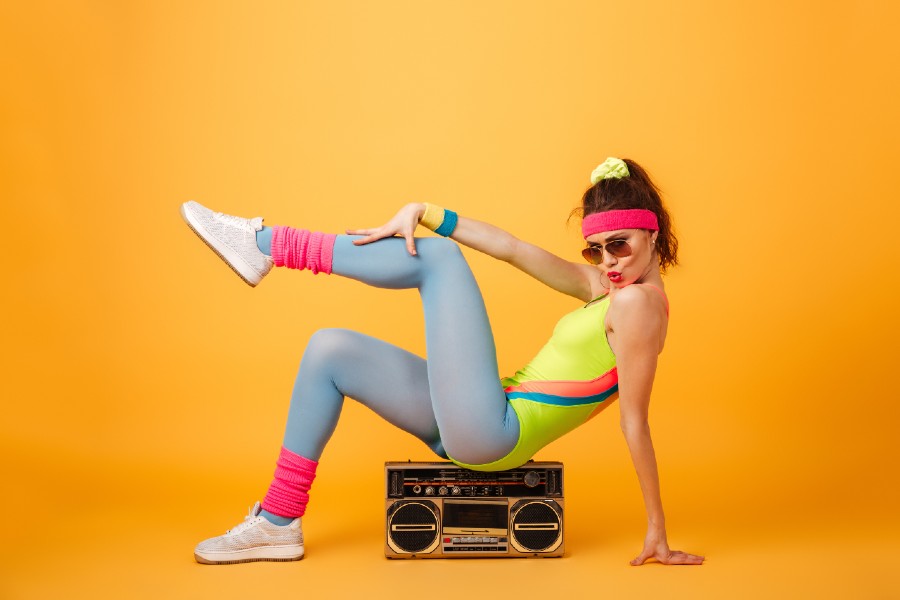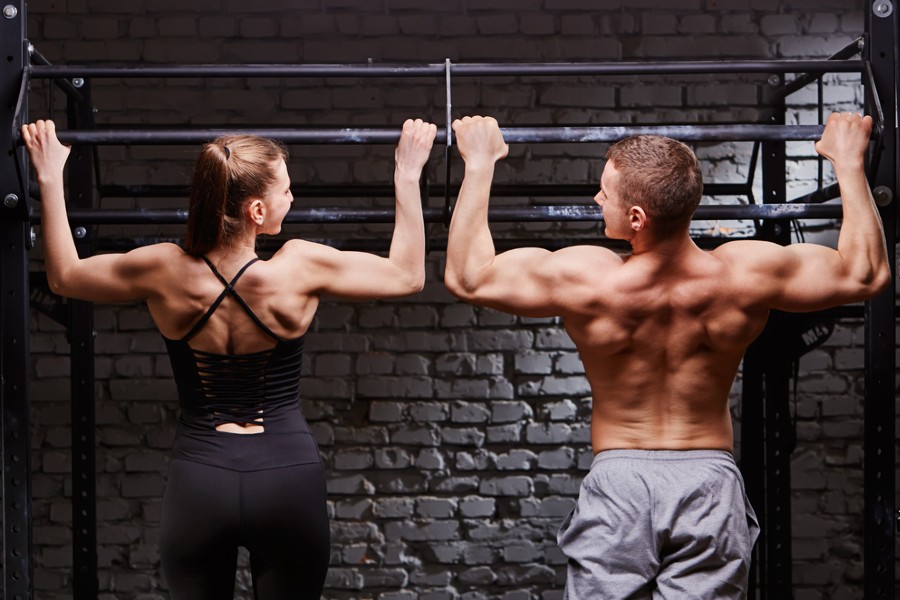This article was updated May, 2023.
From the era of Mr Universe and body building in the 80s to the Jane Fonda-led aerobics revival and the ultra-thin 90s yogi: How gym culture has evolved through the decades…
No pain, no gain has long been the mantra for fitness fans, but if you’re working hard when working out, that doesn’t mean you can’t have some fun too. The need to marry exercise with enjoyment has led to various fitness crazes over the decades from Jane Fonda’s aerobics classes to Zumba taking over the world.
Meanwhile, changes in technology and body image have also influenced fitness fads, while people increasingly want to know how to burn calories in minimal time. Here, we look back at how gym culture has changed with some trends you may remember fondly… and others you may wish to forget…
Eighties Gym Culture - Leotard, anyone?
Back in the Eighties Simon Cowell’s best friend Sinitta was a pop star who had a hit with ‘So Macho’ – and that’s exactly what men hitting the gym in the decade wanted to be. Inspired by muscular action heroes like Arnold Schwarzenegger, Sylvester Stallone and Jean-Claude Van Damme, men wanted to beef up by body building. This meant pumping iron for hours at the gym using machines and heavy weights to do bench presses, deadlifts, squats, cleans and leg curls.
This was coupled with a high protein, low carb diet, full of steaks, eggs and lots of milk. The bulkier the better. The aim was to achieve rock hard pecs, beefy biceps and super strong quads.
While for some the desire to body build was to achieve a toned physique they could show off in tight T-shirts, for others it was aspirational. After all, Arnie had gone from being a little known winner of Mr Universe, to an in-demand Hollywood leading man thanks to his body building.
Meanwhile, the women of the decade were also inspired by a Hollywood star – Jane Fonda. She rose to fame in the Sixties in films including Tall Story and Barbarella and then turned fitness guru in the Eighties when she launched her first exercise video. Women, who may have been put off going to the gym thanks to those Mr Universe beefcakes making it feel like a male domain, embraced Jane Fonda’s Workout.
Her best-selling aerobic-based exercise routine encouraged viewers to ‘feel the burn’ and raise their heart rate while toning the muscles with leg raises and arm reaches. They were encouraged all the way by a leotard-clad Fonda, who sparked a fashion trend for women working out in bright leg warmers with matching belts.
It was in this era that an Australian fitness industry legend was born. Fernwood Fitness’s founder Diana Williams had discovered the joys of weight training and was excited by the impact this kind of exercise had on her body, as opposed to the aerobic style workouts that most women were doing. Because of the heavily male dominated gym space in 1989, Diana set up a tiny space in her home town of Bendigo (initially in a classroom) and encouraged other women to come and exercise there. Two years later, the Bendigo gym had become so popular it gave Ms Williams the idea to expand the business. More than thirty years later, Fernwood Fitness is recognised as a leader in the Australian fitness industry.

The Nineties and the battle against "heroin chic":
In the nineties, aerobics literally stepped up as Step classes became all the rage. These involved various moves using a small step and workouts could be done at home or in group gym classes.
Meanwhile, Mr Motivator became famous for putting viewers through their paces with his breakfast TV appearances and the ‘Thigh Master’ was the must-have piece of equipment for everyone who wanted shapely legs.
The end of the decade saw the rise of super slim yogis who swore doing sun salutations and holding poses like the downward facing dog, tree and half cobra were the secret to good health and wellbeing. Celebrities like Madonna and Geri Halliwell fuelled the trend as they were evangelical about the benefits of yoga.
Geri transformed herself into a self help yoga guru after she left the Spice Girls, telling viewers of her Geri Body Yoga DVD: ‘Yoga is about changing your body and mind from the inside out, teaching you focus, understanding, destressing, detoxing and of course toning your body.’
The 1990s witnessed the rise of a notable cultural shift towards a more slender and waif-like aesthetic, fuelled by the modelling industry. The thinness associated with these models, known as “heroin chic,” became highly influential and sparked discussions and debates about body image, beauty standards, and the impact on young women. In terms of the gym culture in the 1990’s, the focus on achieving a thin and toned physique became more prevalent. Aerobics, step aerobics, and dance workouts gained popularity during this period, as they offered a combination of cardiovascular exercise and toning. For women, the emphasis was on achieving a slim and lean figure rather than building muscle mass.
Gym Culture in the Noughties:

Two fitness classes truly took off in the noughties and remain popular today – Zumba and Spinning.
The Latin-inspired Zumba dance workout started in Colombia and spread around the world as people got their groove on to work up a sweat in time to music. The success of Strictly Come Dancing, which began in 2004, also led to gyms offering a number of other Latin and ballroom-related dance classes to help people get fit.
Spinning had been invented decades earlier in a garage in California but soared in popularity in the noughties as more people starting jumping on static bikes in group sessions for a heart racing, quad burning workout.
Inspired by the feats of long distance runners Paula Radcliffe and Haile Gebreselassie, running also started to become more popular with soaring demand for entries in mass participation races like the London Marathon and many hit the treadmills at gyms to get their training in.
This kind of cardio-based workout was believed to be the best way to stay in shape.
Meanwhile Michael Cunico, Head of Fitness and Head of Personal Training at Fitness First, said the introduction of Crossfit in the noughties ‘had a huge impact on the fitness industry’. At times a polarising topic in the fitness industry, CrossFit did highlight the benefits of strength training with intensity.
He said: ‘Crossfit put more barbells in people’s hands than ever before (including women) and this had a significant impact on how people trained. Suddenly your local health club, which maybe had one or two squat racks previously that were occasionally used, had a line up for people to practise their squats and deadlifts. This was an extremely positive thing as previously the weights room was the domain of the boys.’

The Twenty Tens and the Introduction of the Gym Selfie:
Following on from Crossfit, weight training for men and women continued to gain popularity in this decade, with the aim of achieving a toned physique that’s not as bulky as the Eighties Mr Universe look.
High Intensity Interval Training (HIIT) – doing short bursts of exercise for a short amount of time with a short recovery in between – also became hugely popular.
Explaining why, Michael said: ‘It is most likely due to the effectiveness of this style of training regardless of your training goals, i.e. fat loss, maintaining muscle mass or improving cardiovascular capacity.
‘There is research to suggest that this style of training is more effective than long, steady state cardiovascular training. This style of training is more efficient as well, getting more done in less time which is an attractive option in our very busy society.’
Social Media and Gym Culture:
The emergence of social media added another new element to gym culture as people began to share their workouts and gym selfies on Facebook, Instagram and Twitter. Fitness influencers became more prevalent, with some using the social media platforms to launch themselves into pseudo-celebrity status. Gyms were able to harness the power of their social media presence to publicly project their values and culture, building a community of like-minded people with shared fitness goals.
With “checking in” at the gym and the post-workout mirror selfie becoming mainstream, social media became a central part of gym culture for many. There was also a swathe of fitness apps available for gym go-ers. From metrics tracking to pre-programmed workouts, the inclusion of some kind of technology was now more common than not. The ethos of “If there’s no record of it, it didn’t happen” began to dominate workouts and fitness enthusiasts were now integrating their smart phones with wearable technology. While the incorporation of smart technology can be motivational from an individual perspective, it drives a wedge between community on the gym floor. The casual interaction between members at the gym was overshadowed by wireless headphones and smart phones, making the solo workout less social than it had previously been.
On the flip side, technological developments actually enhanced the interaction between members when it came to group exercise. With products such as MyZone allowing members to sync their wearable technology to a shared screen, people could engage in some friendly competition to push themselves harder in a group setting.
Twenty Twenty and beyond:
The year 2020 impacted the fitness industry like nothing had before. As the global pandemic swept across the world, gyms were forced to shut their doors and business owners faced financial crisis and unprecedented uncertainty. Australia endured some of the world’s strictest lockdown measures and gym owners had to repeatedly pivot to adhere to changing restrictions in order to keep themselves afloat.
The closure of gyms meant that many people started to work out at home for the first time ever. It made personal trainers and gym owners throw themselves into a crash course on Zoom, to deliver face-to-face training remotely and saw home exercise equipment fly off the shelves.
As restrictions eased and businesses were able to re-open, gyms still suffered the flow-on effects of members who felt anxious about shared spaces as well as the hoards of paused memberships that weren’t reactivated.
A new focus on health and fitness:
The shared experience of the pandemic, however, strengthened some communities within individual gyms and brought a new focus on fitness as a holistic pursuit rather than only a physical one. The mental load of the pandemic has seen many people place renewed emphasis on health and fitness, with many making it a higher priority than they had before. This shift towards overall wellbeing, rather than simply working out has seen gym culture include more recovery spaces. Saunas, ice baths and breathwork workshops are bringing a new version of community to gyms and fitness centres.

VR Fitness: What’s it going to look like?
Virtual Reality has already entered the fitness world, but is set to be one of the next big growth areas. The gamification of fitness may bring more people into the gym, which can only be a good thing. Similar to the emergence of smart phones though, the introduction of virtual reality fitness could be a barrier to that social gym community vibe that many business owners are always trying to foster. On the other hand, virtual reality could allow for friendships to be built across new platforms (picture the way current VR board meetings are able to be run). It also could mean that specialised trainers can be accessed by clients from anywhere in the world. It’s fair to say that when it comes to VR fitness, watch this space. Who knows what other forms of fitness lie ahead as tech merges with all areas of our lives?
Original article sponsored by Fitness First, written by Lucy Waterlow for MailOnline in Nov 2015.
Updated by the WNiF Writing Team in May 2023.

Exercise as the Key to Independence for Older Adults
Less than a generation ago, turning 40 was thought of as middle aged, and starting a ‘Fitness Over 40’ exercise program would have been shrugged off as a waste of time for it being too late to get in shape. Now, what we think of as ‘middle aged’ or ‘old’ has changed as people live

Life Fitness Take Premium Cardio Equipment To New Heights
Innovation in the cardio equipment space is competitive and it can be hard to differentiate between brands with a similar price point. The new Symbio™ range from Life Fitness Australia, however, has really shaken up the market with an array of exciting new features. The team from What’s New in Fitness were impressed with the

Introducing The FIT House Of Brands
A new parent company that unifies global fitness brands F45 Training, VAURA Pilates and FS8 has been announced. The launch of FIT (short for Functional Inspired Training) is an exciting moment for the wider fitness community, bringing a variety of exercise and wellbeing modalities under the one umbrella. Here’s what we know so far about

Fitness Racing Continues to Thrive with YOHKA Sports at the Forefront
Obstacle, adventure or fitness racing – whatever you call it, there’s no doubt that people around the world love this dynamic sport. Aussie-born fitness racing brand, YOHKA Sports, recently announced the appointment of Todd Liubinskas as CEO and with the sport gaining serious momentum on a global level, he takes the reigns moving into an

MyZone Appoints Advisory Group On Wearable Technology
MyZone has taken new steps to remain recognised as one of the most ‘relevant’ wearable technologies for the fitness industry, delivering a wearable fitness tracker that shows and rewards effort when you work out. In a new move to stay at the forefront of the industry, MyZone has assembled a ‘thinktank’ of health and fitness

ExPRO Fitness Expo Perth 2025
It’s official… ExPRO Fitness is back in Perth for 2025! Singapore’s leading fitness education and events platform debuted in Western Australia with a two day event in November 2024. The success of the 2024 Summit and Festival has led ExPRO to announce that there will be a 2025 event in Perth with dates still to
